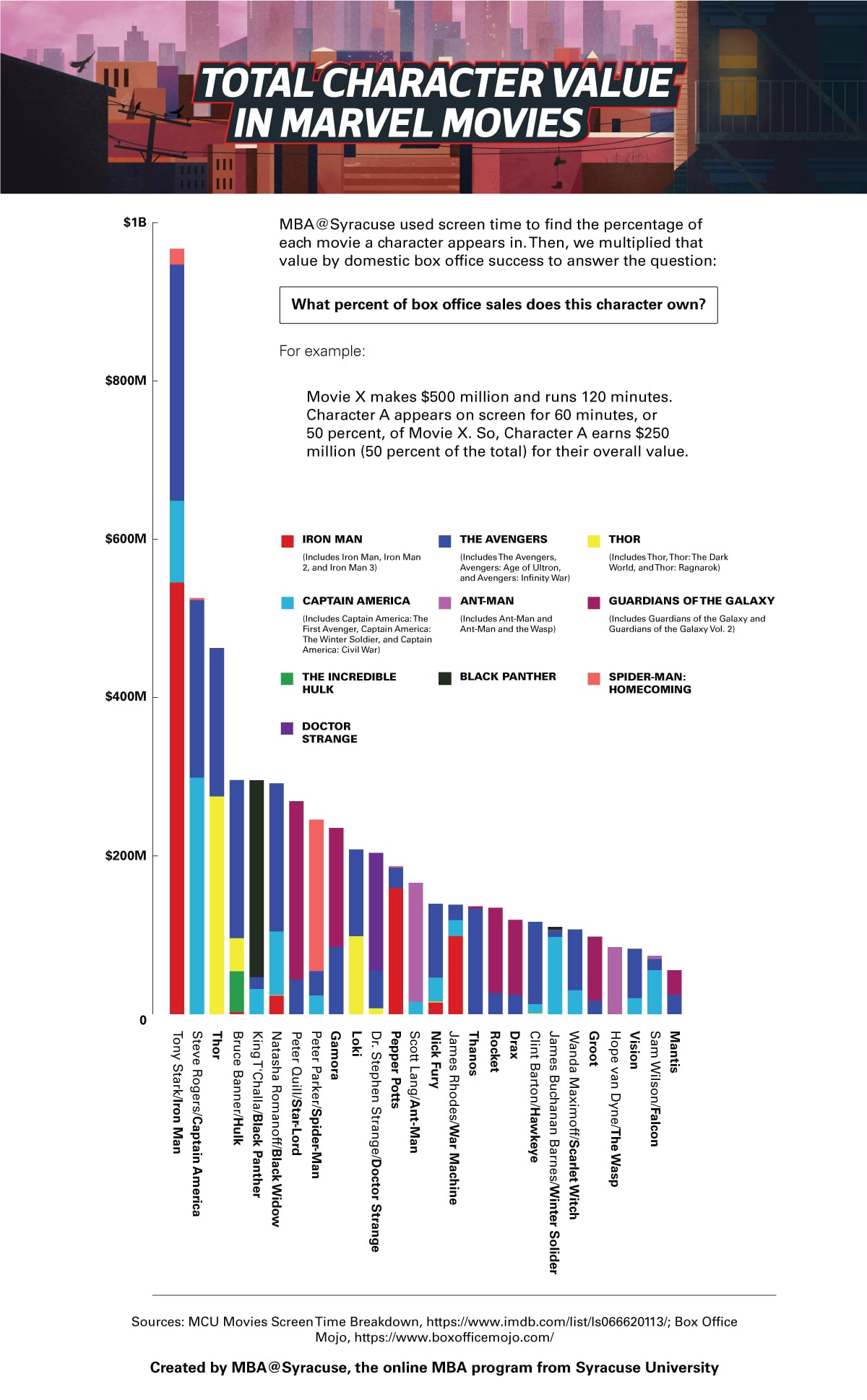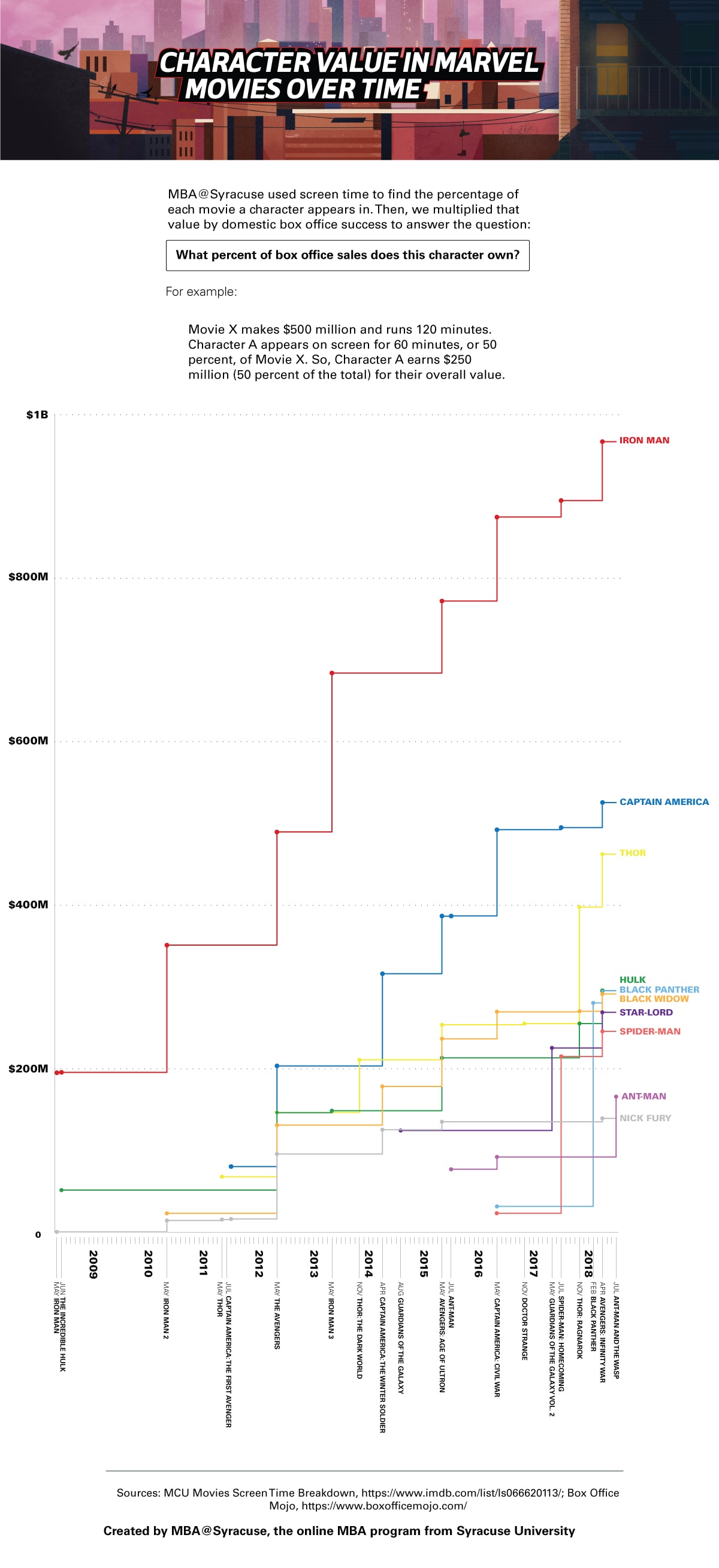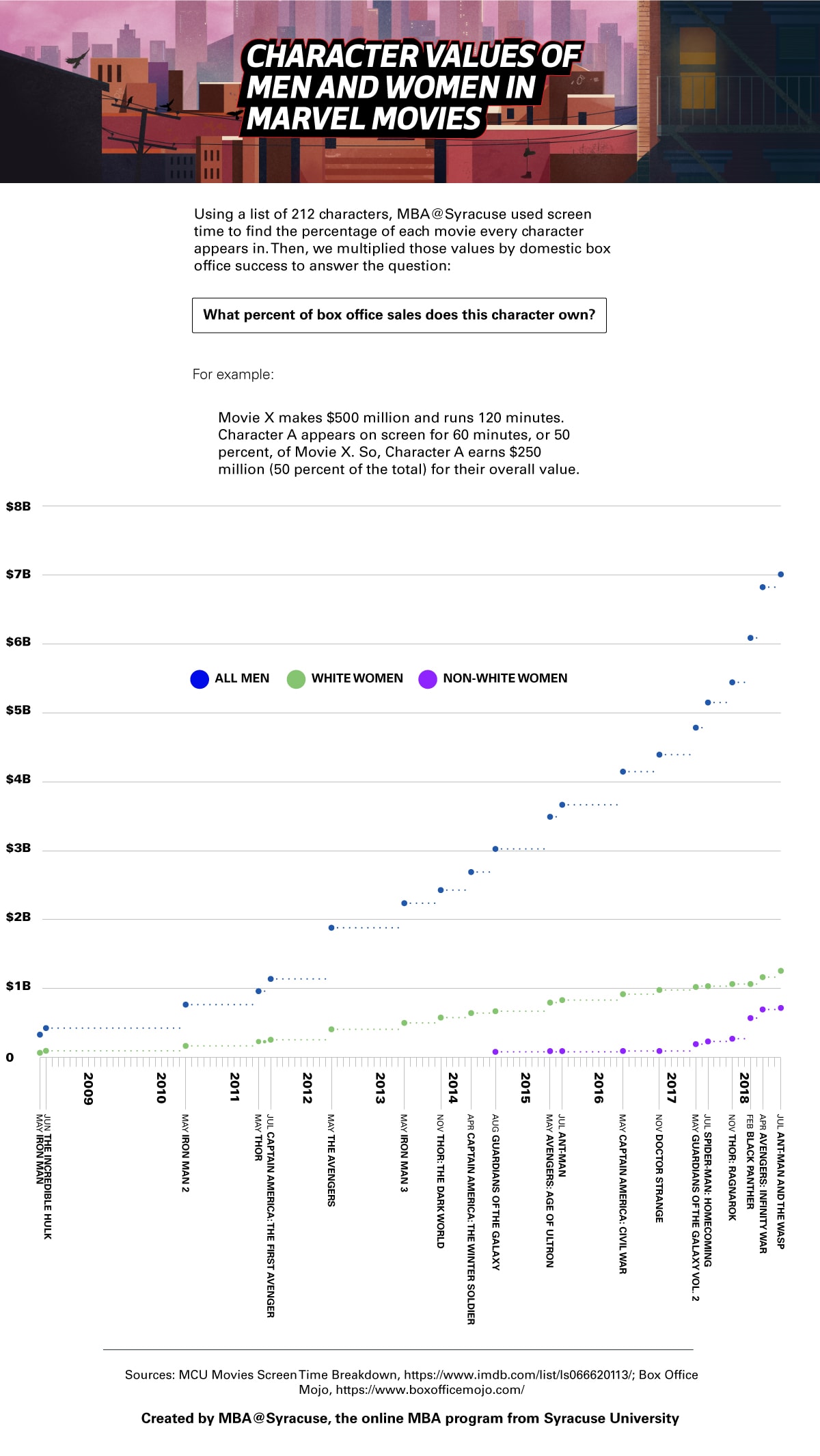Measuring the Value of Marvel Characters

The following may include spoilers for Marvel Studios movies.
Marvel Studios is more than a decade into creating a universe that continues to break the box office — 2018’s Avengers: Infinity War grossed a record $2 billion worldwide.
It’s the kind of lucrative long-term relationship that most franchises dream of.
“The increasing reliance of Hollywood on sequels with franchises of characters indicates a fundamental shift of focus,” said Eunkyu Lee, professor of marketing and associate dean for global initiatives at the Martin J. Whitman School of Management at Syracuse University.
Movies are no longer stand-alone products but part of a larger brand or experience studios are selling to customers. But brands need faces, and selling a relationship for 19 movies requires a lot of them. Since the original Iron Man film in 2008, Marvel has introduced hundreds of names and started eight additional character-based franchises.
“From a purely business point of view, the benefit of owning a large cast of characters is similar to that of investing in a well-diversified portfolio of financial assets,” said Lee, who has researched brand marketing and the impact of movie contract structure on channel scheduling.
Take a look at Marvel’s massive portfolio: How much are the characters worth? How is that used to market movies?
Measuring The Value Of Franchise Film Characters
Using the screen times of more than 200 characters in Marvel Cinematic Universe (MCU) films, MBA@Syracuse determined the amount of money each Marvel character generates from each Marvel movie.
We used screen time to find the percentage of each movie a character appears in. Then, we multiplied that value by domestic box office success to learn what percentage of sales a character owns.
For example: Movie X makes $500 million and runs 120 minutes. Character A appears on screen for 60 minutes. So, Character A owns $250 million (50 percent of the total) in Movie X toward their overall value.
Why did we calculate value this way? We are interested in how characters are leveraged by the studios, not necessarily how they—or the actors portraying them—are perceived by audiences. Characters that are given more screen time in higher-grossing films become more valued by studios; in turn, studios will use those characters to market future films.
Because our analysis of marketing techniques focuses solely on U.S.-based strategies, our calculations include domestic box office sales only.
So, what did we find from our initial data? Here are some key takeaways:
- Tony Stark/Iron Man wins—by a lot. Stark’s tenure in the MCU gives him an advantage: He appears in nine films and logs significant screen time in most. There’s about a 12 percent chance you’ll see Iron Man on the screen at any given moment while watching a Marvel movie.
- Gamora has the highest value of all women. The only female in the top 10, Gamora jumped from 12th to 9th place after Avengers: Infinity War. She had the second-highest screen time in the film, behind Thanos (who moved up 10 spots to 16th after Infinity War).
- Pepper Potts proves that consistency counts. Largely used as a love interest, Potts is tied to more Marvel dollars than Nick Fury, original Avenger Clint Barton/Hawkeye, and Ant-Man, who has two title films of his own.
- King T’Challa/Black Panther broke into the top 5 after only three movies. Bruce Banner/Hulk is only about $120,000 ahead despite appearing in twice as many films.
- Black Panther’s Erik “Killmonger” Stevens and Nakia have maximum impact and minimum screen time. These two characters are the only ones in the top 25 with only one movie appearance (20th and 24th, respectively).

How Can Character Value Change Over Time?
While it might seem obvious that Iron Man owns so much of the franchise, it’s worth considering how he got there. What propelled him to a value almost twice as large as runner-up Captain America?
Looking at the data over time shows a few interesting trends:
- Tony Stark never loses his lead. Stark opens the MCU as the highest-valued character, and that never changes. He averages about $107 million per film, followed by T’Challa’s $98 million average per movie.
- Nick Fury’s value grows more than any other character. Fury’s value is almost 220 times higher now than when he first appeared in Iron Man. For comparison, Thor’s value is almost 6 times higher from start to end, while Doctor Strange experiences the least change—37 percent growth over his three appearances.
- T’Challa dethrones Tony Stark with the highest-valued single performance. Until Black Panther, Stark’s time in Iron Man remained the most lucrative role in any MCU film. The only performance that came close was Stark in Iron Man 3. T’Challa in Black Panther was worth about $50 million more.
- Steve Rogers/Captain America, T’Challa, and Peter Parker/Spider-Man are some of the fastest-earning characters. Each only needed two film appearances to break $200 million, with T’Challa earning the most ($280 million). Measuring success after three movies, Stark returns as the leader with more than $351 million in his first three appearances thanks to early solo films.

How Do Character Groups Compare?
Separating characters into groups can illustrate larger trends over time. We grouped all 212 characters by gender, and then by race, to find how much screen time women get in Marvel’s most successful films.
- Just three women are among the top 20 highest-valued characters. Natasha Romanoff/Black Widow, Pepper Potts, and Gamora are the 6th, 9th, and 12th highest-valued characters, respectively.
- Title roles are new for women in the MCU. Marvel’s Ant-Man and the Wasp made history, with Hope Van Dyne/The Wasp becoming the first woman to be featured by name in a title. Hitting theaters in 2019, Captain Marvel will be the first solo title film for a woman.
- Women of color don’t appear on the list for the first nine films. Gamora’s introduction in Guardians of the Galaxy marks the first appearance of a woman of color on a list of more than 200 characters. That’s changing, though: Valkyrie (Thor: Ragnarok) and Nakia, Shuri, and Okoye (Black Panther) were all given substantial screen time in some of Marvel’s most successful movies.
- The value gap between women and men in Marvel is slowly shrinking. The total character value for women in Marvel was a mere 21 percent of their male counterparts’ after Iron Man. Since Ant-Man and the Wasp, that number now sits at slightly higher than 28 percent.
- Upcoming MCU movies could help close that gap even more. As the first origin film about a woman, Captain Marvel is already set to show women on screen than any other Marvel film in the past, as would a rumored Black Widow project. And with a Black Panther sequel in motion, audiences can expect the women of Wakanda to get even more screen time.

Character Leverage In Marketing
“Good actors are better brands than weak characters. Good characters are better assets than weak [actors],” Lee said.
The decision of how to market large casts and develop a relationship with audiences hinges on the balance between character and cast member. What are studios trying to sell, and what do audiences want to buy?
“Are actors more relatable for fans because they are real human beings?” Lee said. “Or, with the ongoing sophistication of the virtual worlds and electronic social interactions, do people feel stronger relationships with fictional characters and fictitious worlds?”
Trailers can be the most viral form of marketing. The Avengers: Endgame trailer—released Dec. 7, 2018—earned 289 million views in the first 24 hours, breaking the record previously held by the Avengers: Infinity War trailer.
MBA@Syracuse analyzed the trailers for Marvel’s ensemble films (like The Avengers, Avengers: Infinity War, and Avengers: Endgame) to see how Marvel utilizes characters in marketing versus in the movies themselves. Here’s what we found:
- Natasha Romanoff/Black Widow and Loki lost the most time in The Avengers. Despite being on screen for about 17 percent of the movie (more than anyone but Stark and Rogers), Romanoff only appears in 7 percent of the trailer material. Loki has an even bigger discrepancy, occupying 2 percent of the trailers compared to 15 percent of the film.
- Marvel used T’Challa disproportionately in marketing Avengers: Infinity War. Fans might have been surprised to see Black Panther on screen for just 2 percent of Avengers: Infinity War, considering he was in the trailers four times as often.
- The Guardians are saved for last. Bringing all these universes together is perhaps Marvel’s most marketable asset, and the Guardians are the last piece. Using them as a “reveal” is its own marketing tool. The first Avengers: Infinity War trailer keeps the entire Guardians of the Galaxy cast off screen until after the final title sequence.
- The Avengers: Endgame trailer content isn’t surprising. The first 55 seconds consists of a Tony Stark monologue, and that makes sense given his value compared to all other remaining characters. The ending of Infinity War places Marvel back where it started: a much smaller cast of characters, with Iron Man leading the way.
Looking forward, Marvel Studios shows no signs of slowing down. The studio announced release dates for three, mostly untitled, movies a year until 2022.
Inevitably, original actors will finish out their contracts and some characters will die. Fresh faces and new storylines will replace old ones. The only real question is: Nine films in the future, will someone finally out-value Iron Man?
Citation for this content: MBA@Syracuse, Syracuse University’s online MBA program


